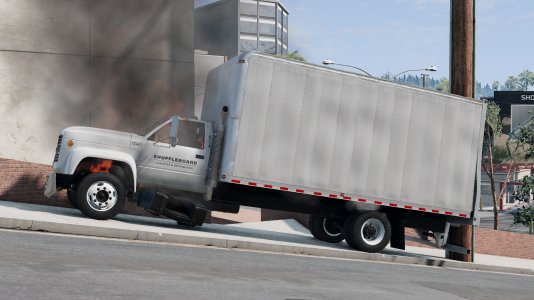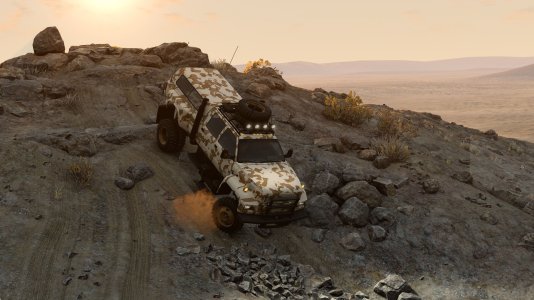In the latest 0.33 BeamNG.drive update, the force feedback for us sim racers has been tweaked and improved. Here is everything you need to know.
In the past, the BeamNG force feedback has been a sticking point for those who like to use their sim racing setups with the soft-body physics simulator. The latest 0.33 update has changed and adjusted a lot of code and physical feedback changes to improve the feedback.

MD-series truck fleeing from the Police. Image: BeamNG
The main focus of the force feedback changes is the reactiveness of the wheel to inputs from the sim. Potholes, jumps and general road feel are much sharper and clearer within the feedback. The detail can be felt right across the full spectrum of input and with a direct drive wheel, the communications from the sim only gets better.
The locking of brakes and losing grip when corning at speed are both fantastically simulated when using cars. The trucks still feel vague at times, especially when they are loaded. The mechanical failures feel much more realistic and less like they want to try and take your arms off when they occur. The best way to describe it would be that the motions are much more gradual as opposed to one either on or off like they used to be pre-update.

Mechanical failures are felt through the force feedback, like when an engine overheats and catches fire.

New force feedback revolutionises drifting. Image: BeamNG.drive
The racing also benefits immensely with the ability to be much more precise with where you position your car and the consequent feedback you get from your vehicle. The most notable change is how the kerbs feel on vanilla circuits like Hirochi Raceway. When you get slightly airborne, the wheel goes light and if you land without it being straight, you can say goodbye to the tracking and consequently, your mint condition race car.
Off-road adventuring, crawling and the hundreds of rally stages are even more accurate after 0.33. If you have never tried BeamNG's rally missions or mods, check out our overview of the discipline and how to get started! Off-road simulation is where BeamNG has always really come alive, and this new force feedback further proves that fact.

Ibushu Covet race car. Image: BeamNG.drive
The road and tarmac simulation is certainly improved, but it still can not be considered on a level with racing simulators such as Assetto Corsa or iRacing. The point of BeamNG is very far away from those titles of course, however, for those who enjoy racing with soft body physics the continued improvement of force feedback is a must.
What do you think about BeamNG's new force feedback? Let us know down in the comment below!
In the past, the BeamNG force feedback has been a sticking point for those who like to use their sim racing setups with the soft-body physics simulator. The latest 0.33 update has changed and adjusted a lot of code and physical feedback changes to improve the feedback.
What has changed?
The scope of changes to the force feedback in 0.33 is wide. Wider compatibility additions make the sim feel much more up-to-date for Linux users and for regular Windows players, a whole array of fixes, changes and additions are waiting to be discovered.MD-series truck fleeing from the Police. Image: BeamNG
The main focus of the force feedback changes is the reactiveness of the wheel to inputs from the sim. Potholes, jumps and general road feel are much sharper and clearer within the feedback. The detail can be felt right across the full spectrum of input and with a direct drive wheel, the communications from the sim only gets better.
The locking of brakes and losing grip when corning at speed are both fantastically simulated when using cars. The trucks still feel vague at times, especially when they are loaded. The mechanical failures feel much more realistic and less like they want to try and take your arms off when they occur. The best way to describe it would be that the motions are much more gradual as opposed to one either on or off like they used to be pre-update.
Mechanical failures are felt through the force feedback, like when an engine overheats and catches fire.
Racing and drifting
The new agile force feedback model is especially useful in racing and drifting. Coupled with the 'Quick Ratio Steering Rack' option available in many cars, the drifting missions are leagues above where they were before 0.33. As a further change implemented in the update, drifting detection was also changed and modified to recognise smaller and slower drifts. Could BeamNG challenge Assetto Corsa as the home of the drifting community one day?New force feedback revolutionises drifting. Image: BeamNG.drive
The racing also benefits immensely with the ability to be much more precise with where you position your car and the consequent feedback you get from your vehicle. The most notable change is how the kerbs feel on vanilla circuits like Hirochi Raceway. When you get slightly airborne, the wheel goes light and if you land without it being straight, you can say goodbye to the tracking and consequently, your mint condition race car.
Off-road adventuring, crawling and the hundreds of rally stages are even more accurate after 0.33. If you have never tried BeamNG's rally missions or mods, check out our overview of the discipline and how to get started! Off-road simulation is where BeamNG has always really come alive, and this new force feedback further proves that fact.
Ibushu Covet race car. Image: BeamNG.drive
The road and tarmac simulation is certainly improved, but it still can not be considered on a level with racing simulators such as Assetto Corsa or iRacing. The point of BeamNG is very far away from those titles of course, however, for those who enjoy racing with soft body physics the continued improvement of force feedback is a must.
What do you think about BeamNG's new force feedback? Let us know down in the comment below!


